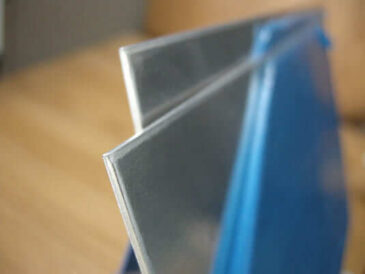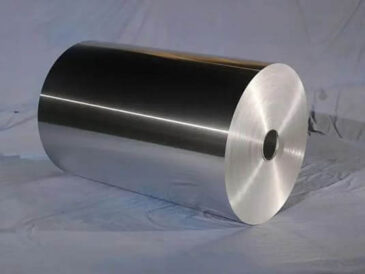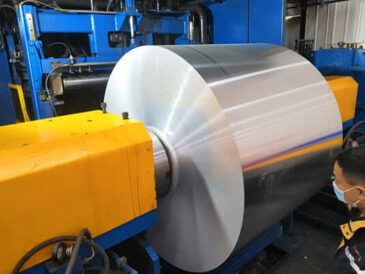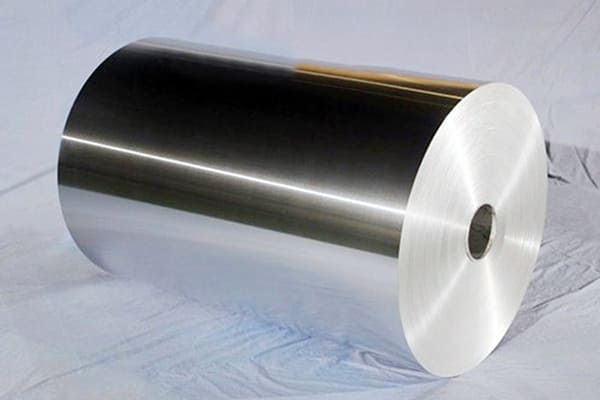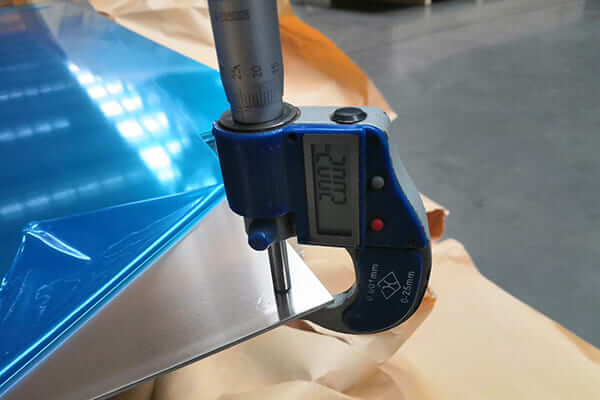Coated Aluminum Foil Overview
Coated aluminum foil is a special-coated aluminum foil product that can be widely used in food packaging, pharmaceutical packaging, building materials, electronic products and other fields. Coated aluminum foil usually consists of base aluminum foil and coating materials, and is made through coating, drying and other processes.
The main function of coated aluminium foil is to enhance the functionality of aluminum foil so that it has better heat resistance, moisture resistance, anti-corrosion and heat insulation properties. Coating materials usually include polyester resin, polyethylene, polypropylene, etc. These materials have excellent chemical resistance and physical properties. By coating the surface of aluminum foil, the performance and added value of aluminum foil can be effectively improved, making it more suitable for packaging and applications in different fields.

Coated aluminum foil
As a highly functional aluminum foil product, coated aluminum foil has wide application prospects and market demand. With the continuous advancement of technology and the expansion of application fields, coated foil will show its unique advantages and value in more fields.
What is coated aluminium foil?
Coated aluminum foil refers to a special treatment process that covers the surface of aluminum foil with one or more layers. This treatment improves the properties of the aluminum foil, making it more suitable for a variety of different applications.
Coated aluminum foil is commonly used and widely used in areas such as food packaging, construction materials, electronics, and medical devices. There are mainly the following types:
- 1. Coating protective layer: The coating can protect the surface of the aluminum foil and prevent the aluminum foil from being damaged by the outside world. For example, an aluminum oxide coating can improve the corrosion resistance of aluminum foil, making it more durable.
- 2. Coating reinforcement layer: By coating a layer of reinforcement material on the surface of the aluminum foil, the strength and hardness of the aluminum foil can be improved, making it more wear-resistant and durable.
- 3. Coating toughening layer: Coating a layer of toughening material on the surface of the aluminum foil can improve the toughness and tear resistance of the aluminum foil and make it more durable.
- 4. Coating insulation layer: By coating a layer of insulation material, the insulation performance of aluminum foil can be improved, making it more suitable for applications in high temperature environments.
- 5. Coated barrier layer: Aluminum foil itself has good barrier properties, and by coating one or more layers of barrier materials on the surface, its barrier properties against moisture, oxygen or other harmful substances can be improved.
The preparation methods of coated aluminium foil mainly include coating method, printing method and hot pressing method. There are also many choices for coating materials, including polyethylene, polyester, polyamide, epoxy resin, etc.
In the field of food packaging, coated aluminum foil can effectively protect food, extend the shelf life of goods, and meet food hygiene standards, so it is widely favored by food processing companies. In the field of building materials, coated aluminum foil can be used as building insulation materials to improve the thermal insulation performance of buildings. In addition, coated aluminum foil also has important application value in the fields of electronic products and medical devices.
In short, coated aluminum foil can improve the performance of aluminum foil through a special treatment process of one or more layers covering the surface of the aluminum foil, making it more suitable for various application fields and has broad market prospects.
Coated aluminum foil contains layers of material
Coated aluminum foil is a specially treated material made of coated aluminum foil substrate, which has properties such as moisture-proof, anti-corrosion, and radiation protection. Its main components are aluminum foil and coating materials. The coating materials usually include plastic materials such as polyethylene, polypropylene, and polyvinyl chloride.
- 1. Aluminum (Al): Aluminum is the main component element of coated aluminium foil, accounting for most of the content. Aluminum has good thermal and electrical conductivity, is lightweight and easy to process, so it is widely used in fields such as food packaging, building materials and industrial materials.
- 2. Polyethylene (PE): Polyethylene is a common coating material with good moisture-proof and anti-corrosion properties. It can effectively protect the aluminum foil substrate and reduce environmental pollution. Polyethylene also improves the processability and plasticity of coated aluminum foil.
- 3. Polypropylene (PP): Polypropylene is also a commonly used coating material with excellent wear resistance and chemical resistance, which can effectively enhance the mechanical strength and durability of coated aluminum foil.
- 4. Polyvinyl chloride (PVC): PVC is a plastic material with good moisture-proof and heat-insulating properties. It can effectively reduce the thermal conductivity of coated aluminum foil and has good properties for susceptible products such as food and pharmaceuticals. protective effect.
- 5. Other additives: Coated aluminum foil may also add some other materials, such as antioxidants, plasticizers, fire retardants, etc., to improve the performance and durability of coated aluminium foil.
In general, the components of coated aluminum foil mainly include aluminum and one or more coating materials. These materials interact to form a new material with excellent properties and are widely used in packaging, construction, electronics, medicine and other fields.
Processing technology of coated aluminium foil
Coated aluminum foil is a process in which other materials are coated on the surface of aluminum foil to change its properties and uses. The coated aluminum foil processing technology mainly includes material preparation, surface treatment, coating, drying and coiling.
First, prepare materials. Choose high-quality aluminum foil as the base material, and determine the materials that need to be coated according to different usage requirements, which usually include polymer resins, coating agents and other additives.
Secondly, carry out surface treatment. The surface of the aluminum foil needs to be degreased, deoxidized and roughened to ensure that the coating can adhere firmly to the surface of the aluminum foil and provide better coverage and adhesion.
Next, proceed to the coating operation. The pre-prepared coating material is usually evenly coated on the surface of the aluminum foil using roller coating, blade coating or spray coating to form the required functional coating. During the coating process, parameters such as coating speed, coating thickness, temperature and humidity need to be controlled to ensure the quality and uniformity of the coating.

Aluminum foil coating process
Then, drying is performed. After the coating is completed, it needs to be dried to remove the solvent in the coating and ensure that the coating can be fully cured and firmly bonded to the aluminum foil surface. Usually an oven or drying chamber is used for heat treatment, and ultraviolet curing technology can also be used for rapid curing.
Finally, take up the coil. The dried coated foil is rolled into rolls or cut into sheets. After packaging and quality inspection, it can be put into the market.
The coating aluminium foil processing technology has certain technical difficulties and production requirements, and each link needs to be strictly controlled to ensure the uniformity, adhesion and durability of the coating. At the same time, in response to different needs, the coating formula and process parameters also need to be optimized to meet the use requirements in different fields.
Coated aluminum foil is widely used in food packaging, pharmaceutical packaging, building materials, electronic products, aerospace and other fields. It can provide excellent moisture resistance, corrosion resistance, heat insulation, light isolation, anti-skid and other functions, improving the performance and performance of various products. Extended service life provides important protection.
What are the classifications of coated aluminum foil?
Coated aluminium foil is a product that is coated on the surface of aluminum foil and can be classified according to different coating materials and uses. Generally speaking, coated aluminum foil can be mainly divided into the following categories:
1. Polymer-coated aluminum foil: This type of coated aluminium foil is mainly coated with a layer of polymer material on the surface of the aluminum foil. Common polymer materials include polyethylene, polypropylene, polyester, etc. Polymer-coated aluminum foil is mainly used in the packaging industry and can be used in food packaging, pharmaceutical packaging and other fields. It has good barrier properties and preservation properties.
2. Painted aluminum foil: This kind of coated aluminum foil is painted on the surface of the aluminum foil. Common painting materials include epoxy resin, polyurethane, acrylic, etc. Paint-coated aluminum foil is mainly used in construction, furniture, electronic products and other fields to improve the corrosion resistance and decorative properties of aluminum foil.
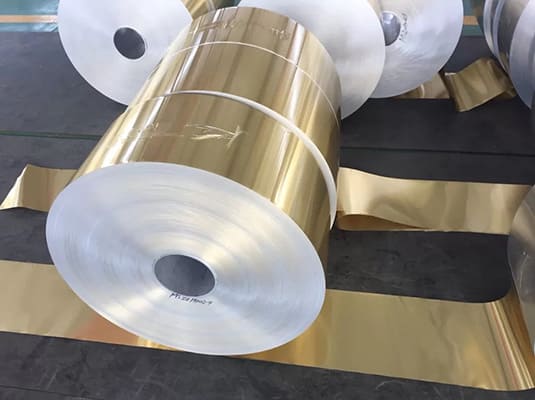
Color coated aluminum foil
3. Thin film coated aluminum foil: This kind of coated aluminium foil is coated with a special film material on the surface of the aluminum foil. Common film materials include PET film, OPP film, PVC film, etc. Film-coated aluminum foil is mainly used in electronic products, building materials, packaging materials and other fields to improve the mechanical strength and wear resistance of aluminum foil.
4. Adhesive coated aluminum foil: This coated aluminium foil is coated with a layer of adhesive on the surface of the aluminum foil. Common adhesives include polyurethane adhesives, hot melt adhesives, etc. Adhesive-coated aluminium foil is mainly used in packaging, building materials and other fields to improve the bonding and sealing properties of aluminum foil.
The above are some common classifications of coated aluminum foil. Different coating materials and uses determine the characteristics and application range of coated aluminum foil. With the continuous advancement of science and technology, the varieties and application fields of coated aluminum foil will continue to expand and improve, providing more solutions for various industries.
What are the uses of coated aluminum foil?
Coated aluminium foil is a product that is coated with a layer of different materials on the surface of aluminum foil. It has the excellent properties of aluminum foil and adds the characteristics of other materials, so it has a wide range of uses in various fields. Here are some of the main uses of coated aluminum foil:
1. Food packaging: Coated aluminum foil is usually used for food packaging, including chocolate, cheese, coffee, milk powder, etc. Due to its ability to isolate oxygen, moisture and light, it can extend the shelf life of food and maintain its freshness and taste.

Coated aluminum foil for container
2. Pharmaceutical packaging: Coated aluminium foil is also widely used in the field of pharmaceutical packaging, such as pharmaceutical packaging, medical device packaging, etc. It can effectively isolate water vapor, oxygen and ultraviolet rays, protecting the quality and stability of drugs and medical devices.
3. Insulation materials: Since coated aluminum foil has excellent thermal conductivity and insulation properties, it can be used as insulation materials, such as in construction, automobiles, electronic products and other fields. It can effectively insulate and block external temperature changes, and play the role of heat preservation and insulation.
4. Anti-corrosion packaging: In the chemical industry, coated aluminum foil can be used for anti-corrosion packaging, such as for the packaging of coated items such as chemicals, pesticides, paints, etc. It can effectively block the penetration of chemicals and gases and protect packaged items from erosion.
5. Pharmaceutical dressings: Coated aluminium foil can also be used in the field of pharmaceutical dressings, such as medical dressings, dressing sheets, etc. It can effectively prevent bacterial infection and external pollution, protect wounds and promote wound healing.
6. Industrial materials: In the industrial production process, coated aluminum foil can also be used as an important industrial material, such as in electroplating, painting, heat treatment and other fields. It can play a role in protection, reflection, conduction, etc., and improve production efficiency and product quality.

Aluminum foil tape
To sum up, coated aluminum foil has a wide range of uses, including food packaging, medical packaging, insulation materials, anti-corrosion packaging, pharmaceutical dressings, industrial materials and other fields, providing convenience and security to all walks of life. With the continuous development of technology and the deepening of application, coated aluminium foil will have broader application prospects in the future.
Coated aluminum foil price calculation method
The price of coated aluminum is usually calculated based on the following aspects:
- 1. Basic price of aluminum foil: The price of aluminum foil is affected by many factors such as market supply and demand, raw material prices, production costs, etc. Generally speaking, the basic aluminum foil price is calculated per ton and depends on market fluctuations.
- 2. Coating process cost: If the aluminum foil requires surface coating treatment, such as anti-rust coating, food-grade packaging coating, etc., the cost of the coating process will also be included.
- 3. Customization according to customer needs: If the customer has special needs, for example, the customer needs to customize coated aluminium foil with special specifications, special materials, and special functions, then the customization fee will be calculated based on the difficulty of customization and the demand.
- 4. Delivery location and transportation costs: If the customer requires door-to-door delivery of aluminum foil goods, the transportation costs will be calculated based on the delivery location and transportation method.
- 5. Market factors: Market factors will also have a certain impact on the price of coated aluminum foil, such as market fluctuations, seasonal demand changes, etc.
In general, the calculation of the price of coated aluminium foil is a relatively comprehensive process that requires consideration of raw material prices, processing techniques, customization requirements, transportation costs and other factors. Usually, customers need to put forward specific requirements to the aluminum foil manufacturer or supplier, and then the manufacturer will give a corresponding quotation. According to the needs and requirements of customers, different manufacturers and suppliers can be selected to compare and find the most cost-effective coated aluminum foil products.
More detials:https://hw-alu.com/products/coated-aluminum-foil.html
Casting production process and its introduction
The purpose of melting and casting is to produce alloys with satisfactory composition and high purity of melt, so as to create favorable conditions for casting alloys of various shapes.
Melting and casting process steps: batching --- feeding --- melting --- stirring after melting, slag removal --- pre-analysis sampling --- adding alloy to adjust the composition, stirring --- refining --- static Setting——Guide furnace casting.
Hot rolling production process and its introduction
- 1. Hot rolling generally refers to rolling above the metal recrystallization temperature;
- 2. During the hot rolling process, the metal has both hardening and softening processes. Due to the influence of deformation speed, as long as the recovery and recrystallization process is too late, there will be a certain work hardening;
- 3. The recrystallization of the metal after hot rolling is incomplete, that is, the coexistence of recrystallized structure and deformed structure;
- 4. Hot rolling can improve the processing performance of metals and alloys, reduce or eliminate casting defects.
- 1. The casting and rolling temperature is generally between 680°C and 700°C. The lower the better, the stable casting and rolling line usually stops once a month or more to re-stand. During the production process, it is necessary to strictly control the liquid level of the front tank to prevent low liquid level;
- 2. Lubrication uses C powder with incomplete combustion of gas for lubrication, which is also one of the reasons for the dirty surface of casting and rolling materials;
- 3. The production speed is generally between 1.5m/min-2.5m/min;
- 4. The surface quality of products produced by casting and rolling is generally relatively low, and generally cannot meet products with special physical and chemical performance requirements.
- 1. Cold rolling refers to the rolling production method below the recrystallization temperature;
- 2. There will be no dynamic recrystallization during the rolling process, and the temperature will rise to the recovery temperature at most, and the cold rolling will appear in a work hardening state, and the work hardening rate will be large;
- 3. The cold-rolled sheet and strip have high dimensional accuracy, good surface quality, uniform structure and performance, and products in various states can be obtained with heat treatment;
- 4. Cold rolling can roll out thin strips, but at the same time, it has the disadvantages of high energy consumption for deformation and many processing passes.
- 1. Finishing is a processing method to make the cold-rolled sheet meet the customer's requirements, or to facilitate the subsequent processing of the product;
- 2. The finishing equipment can correct the defects produced in the hot rolling and cold rolling production process, such as cracked edge, oily, poor plate shape, residual stress, etc. It needs to ensure that no other defects are brought into the production process;
- 3. There are various finishing equipments, mainly including cross-cutting, slitting, stretching and straightening, annealing furnace, slitter, etc.
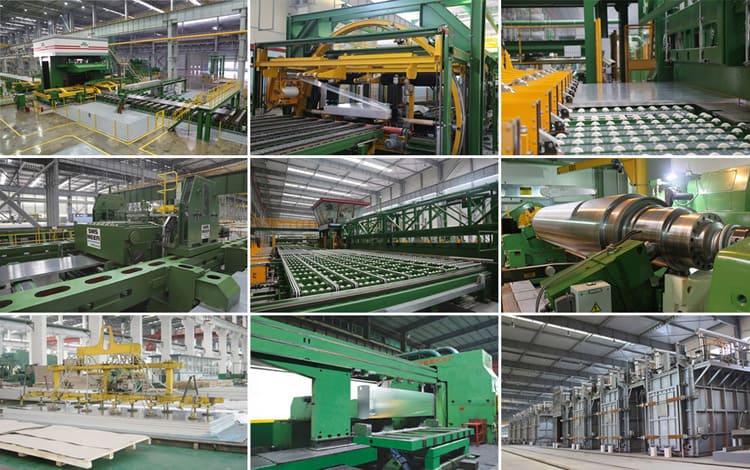
Casting and rolling process
Casting and rolling process: liquid metal, front box (liquid level control), casting and rolling machine (lubrication system, cooling water), shearing machine, coiling machine.
Cold rolling production process

Introduction to finishing production process
Aluminum alloy has the characteristics of low density, good mechanical properties, good processing performance, non-toxic, easy to recycle, excellent electrical conductivity, heat transfer and corrosion resistance, so it has a wide range of applications.
Aerospace: used to make aircraft skins, fuselage frames, girders, rotors, propellers, fuel tanks, wall panels and landing gear struts, as well as rocket forging rings, spacecraft wall panels, etc.
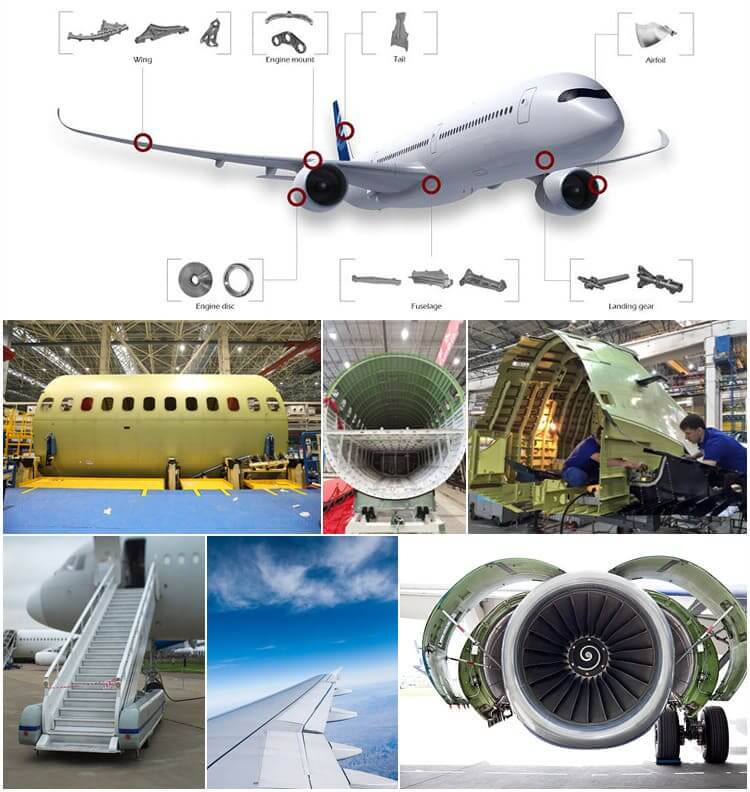
Aluminum alloy used for aerospace
Transportation: used for car body structure materials of automobiles, subway vehicles, railway passenger cars, high-speed passenger cars, doors and windows, shelves, automotive engine parts, air conditioners, radiators, body panels, wheels and ship materials.
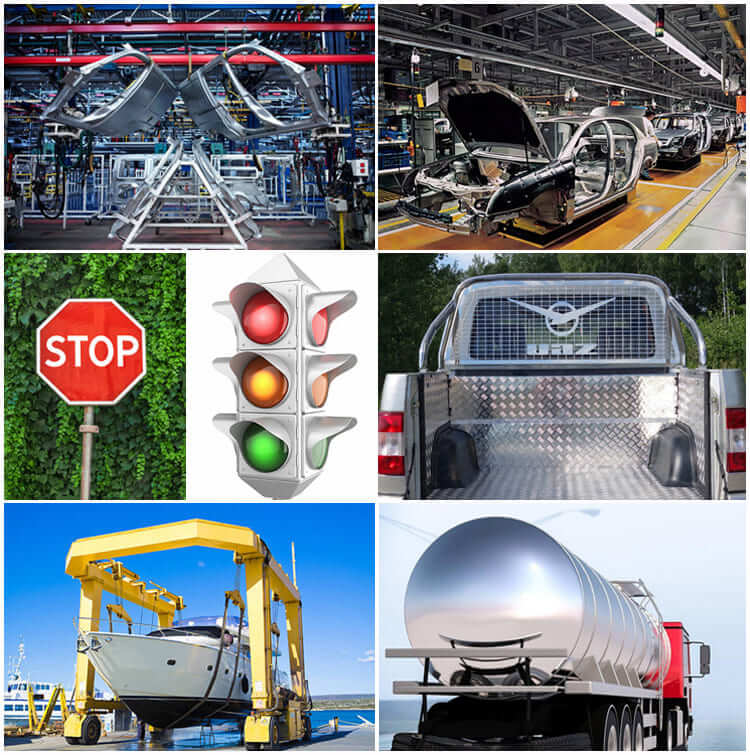
Traffic application
Packaging: All-aluminum pop cans are mainly used as metal packaging materials in the form of thin plates and foils, and are made into cans, lids, bottles, barrels, and packaging foils. Widely used in the packaging of beverages, food, cosmetics, medicines, cigarettes, industrial products, medicines, etc.
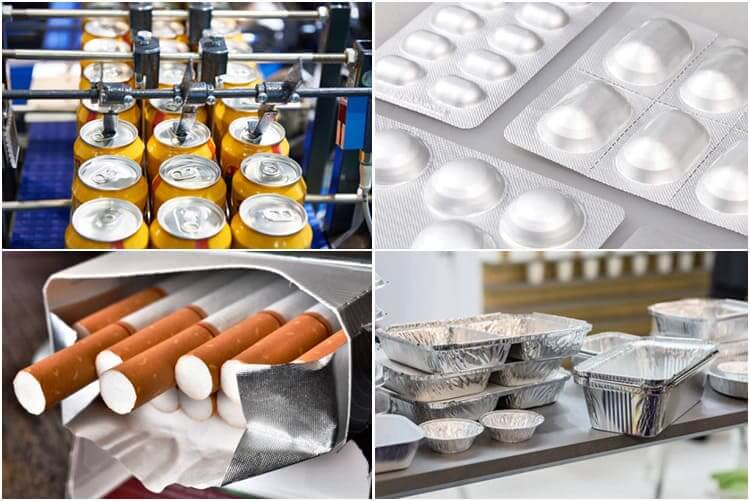
Packaging application
Printing: Mainly used to make PS plates, aluminum-based PS plates are a new type of material in the printing industry, used for automatic plate making and printing.

PS printing
Architectural decoration: aluminum alloy is widely used in building structures, doors and windows, suspended ceilings, decorative surfaces, etc. due to its good corrosion resistance, sufficient strength, excellent process performance and welding performance.
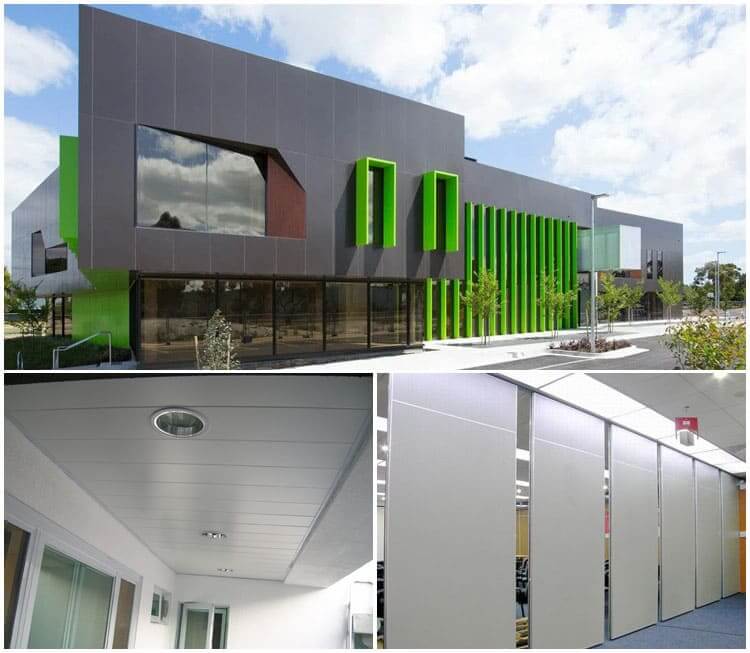
Aluminum alloy construction application
Electronic products: computers, mobile phones, refrigerator shells, radiators, etc.

Electronic product application
Kitchen supplies: aluminum pots, aluminum basins, rice cooker liners, household aluminum foil, etc.

Kitchen application
Packaging Of Aluminum Sheet/Coil
Every detail of packaging is where we pursue perfect service. Our packaging process as a whole is as follows:
Lamination: clear film, blue film, micro-mucosal, high-mucosal, laser cutting film (2 brands, Novacell and Polyphem);
Protection: paper corner protectors, anti-pressure pads;
drying: desiccant;
Tray: fumigated harmless wooden tray, reusable iron tray;
Packing: Tic-tac-toe steel belt, or PVC packing belt;
Material Quality: Completely free from defects such as white rust, oil spots, rolling marks, edge damage, bends, dents, holes, break lines, scratches, etc., no coil set.
Port: Qingdao or other ports in China.
Lead time: 15-45 days.

Aluminum sheet/plate packaging process
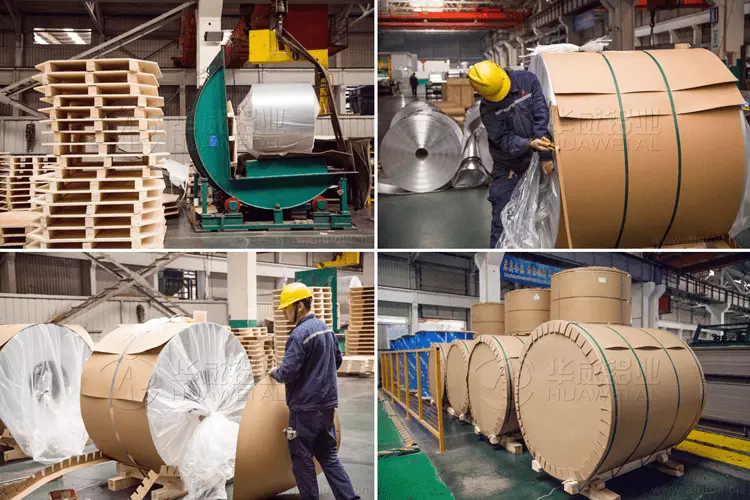
Aluminum coil packaging process
F: Are you a manufacturer or a trader?
Q: We are a manufacturer, our factory is at No.3 Weier Road, Industrial Zone, Gongyi, Henan, China.
F: What is the MOQ for ordering the product?
Q: Our MOQ is 5 tons, and some special products will have a minimum order quantity of 1 or 2 tons.
F: How long is your lead time?
Q: Generally our lead time is about 30 days.
F: Do your products have quality assurance?
Q: Yes, if there is a quality problem with our products, we will compensate the customer until they are satisfied.
Related Products
Latest Blogs
6061 vs 7075 aluminum
"6061" and "7075" are two common aluminum alloy grades, which are widely used in many industrial fields, especially in aviation, aerospace, transportation and structural manufacturing.
Aluminum Foil Used in Air Fryers
Aluminum foil is widely used in daily life, mainly due to its light weight, good ductility, moderate price, and excellent heat conduction and light-shielding properties.
Reasons why the surface of honeycomb aluminum foil cannot be bonded with the adhesive
Aluminum honeycomb panels have good performance in use. They have good strength and good impact resistance. They can be well designed in use. Therefore, they are widely used at present.
Introduction hardness of 1000-8000 series aluminum alloys
1000-8000 series basically covers all aluminum alloy series products. Different series of products have different performance and hardness.






